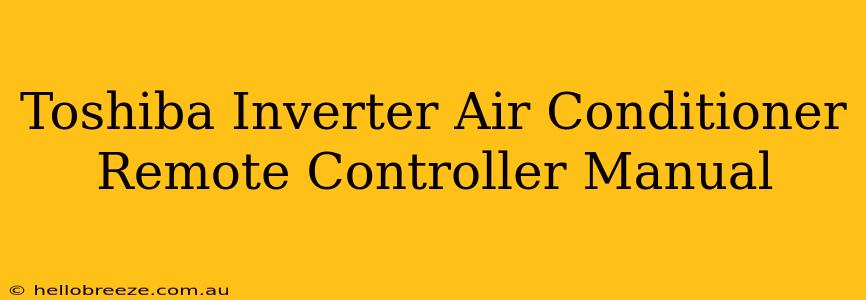Finding the right information for your Toshiba Inverter air conditioner remote can be frustrating. This comprehensive guide will walk you through understanding your remote controller, troubleshooting common issues, and maximizing your air conditioner's performance. We'll cover everything from basic operation to advanced features.
Understanding Your Toshiba Inverter Air Conditioner Remote
First, identify the specific model of your Toshiba Inverter air conditioner remote. The model number is usually printed on the back or bottom of the remote. This will help you find the most accurate manual and troubleshooting tips online (though you won't find download links here!). Knowing your model will allow you to locate the specific instructions tailored to your unit's capabilities.
Key Features and Buttons
Most Toshiba Inverter remote controllers share similar functionality, though the button layout and specific features might vary slightly. Common features include:
-
Power On/Off: This is the most basic function – turning your air conditioner on and off.
-
Mode Selection: This allows you to choose between cooling, heating, fan, and possibly other modes like dehumidification or auto.
-
Temperature Adjustment: Use the up and down arrows to adjust the desired room temperature.
-
Fan Speed: Select from low, medium, high, or auto fan speeds.
-
Swing/Vane Control: This controls the direction of the air vents, allowing for optimal air distribution.
-
Timer Functions: Set timers for on/off operations to schedule cooling or heating according to your needs.
-
Sleep Mode: Gradually adjusts the temperature during sleep for energy savings and comfort.
Troubleshooting Common Remote Issues
Even the best remote controllers can experience problems. Here are some common issues and potential solutions:
Remote Not Responding
- Battery Check: The most common culprit! Replace the batteries with fresh ones.
- Remote Sensor: Make sure nothing is obstructing the sensor on your air conditioner unit. Dust or obstructions can interfere with the signal.
- Distance: Try moving closer to the unit. The signal strength can weaken with distance.
- Remote Alignment: Point the remote directly at the sensor on the air conditioner.
Incorrect Temperature Readings
- Sensor Obstruction: Ensure that the air conditioner's temperature sensor isn't blocked by curtains or furniture.
- Calibration: Some models have a calibration feature (check your manual).
- Room Conditions: Extreme temperatures or humidity can affect readings.
Specific Function Malfunctions
If a particular button or function isn't working, carefully review your remote's instructions. Understanding the functionality of each button is crucial for efficient troubleshooting.
Maximizing Your Air Conditioner's Performance
Beyond basic operation, understanding your remote’s features can optimize your air conditioning experience:
-
Utilize Timer Settings: Program your air conditioner to turn on before you arrive home or turn off when you leave, saving energy and reducing costs.
-
Experiment with Fan Speeds: Higher fan speeds cool faster, but lower speeds are more energy-efficient. Find the balance that suits your comfort and budget.
-
Optimal Swing/Vane Control: Adjust the air vents to distribute cool air evenly throughout the room, preventing cold or hot spots.
-
Regular Maintenance: Clean the air filter regularly to maintain optimal performance and efficiency.
By understanding your Toshiba Inverter air conditioner remote controller and its features, you can enjoy consistent comfort and energy savings. Remember to always consult your specific model's manual for detailed instructions and troubleshooting information. This guide provides a general overview; specifics will vary depending on your model number.

